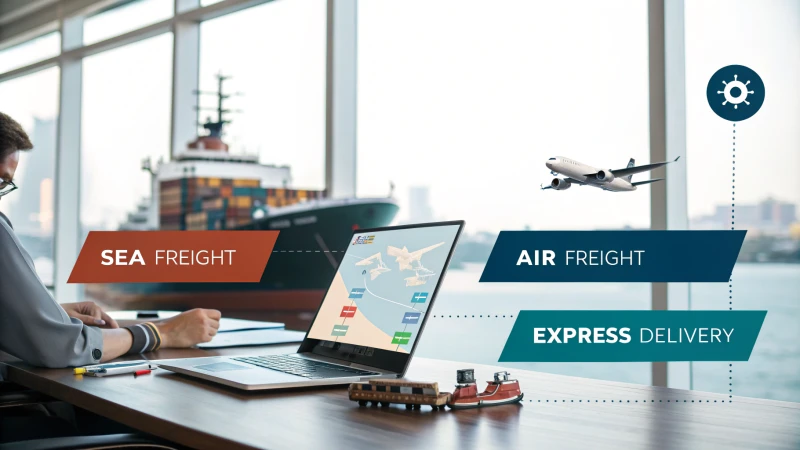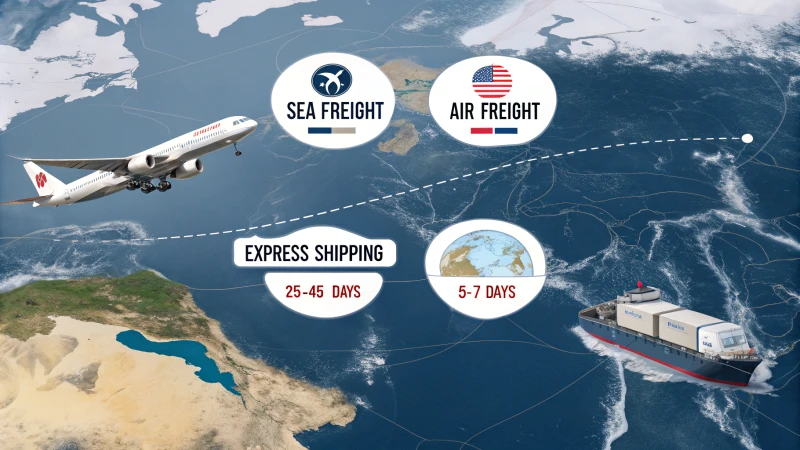Thinking about bringing goods from China to Italy? Trust me, knowing shipping times really changes your plans. Maybe this is very important.
Shipping times from China to Italy depend on the transport method. Sea freight requires 25-45 days. Air freight usually needs 5-7 days. Express options take 5-7 days too. Port congestion might really change these times. Customs can probably affect them as well.
I have waited for shipments, so I understand the mix of excitement and worry. Importing taught me how shipment methods change delivery times. Sea freight takes 25 to 45 days. Days seem endless while you check tracking updates. Air freight moves items faster, usually in 5 to 7 days. This speed really suits valuable goods when quick delivery is crucial. Each method offers both benefits and drawbacks. Port congestion and customs delay shipments. Plans can be easily disrupted by these unexpected issues.
Sea freight from China to Italy takes 25-45 days.True
This claim is true as sea freight is the slowest shipping method, typically requiring 25-45 days for delivery from China to Italy.
Air freight is faster than sea freight for shipping.True
This claim is true; air freight generally takes only 5-7 days, making it significantly faster than sea freight.
What Are the Different Shipping Options Available?
Shipping can feel very confusing, but it doesn't have to be! Different methods for shipping exist. I want to share my experiences to help your shipping process become much easier.
**When looking at shipping methods, think about sea freight for large shipments (25-45 days), air freight for quick delivery (5-7 days) or express shipping for urgent packages (5-7 days). Compare the cost with how fast you need it to decide what's best!
Overview of Shipping Options
Shipping from one place to another involves looking at all available choices. Each way has good and bad points related to cost, speed and how much it carries. Here's a helpful breakdown꞉
Sea Freight
I'll always remember my first sea freight experience. Waiting for a huge container with electronics was exciting. It took 30-45 days to arrive. It seemed very long! But shipping this way saved money for large loads. Delays can occur, especially during busy seasons or at crowded ports, which can be frustrating. More details are available here.
Air Freight
Air freight suits those who need speed. Once, a client needed fast delivery of high-value items. We chose air freight and the package reached them in 5-7 days. It's pricey but seeing my client happy made it all worth it. Learn more about air freight.
Express Shipping
Express shipping is incredible for urgent needs. I once sent a small parcel through DHL. It arrived in only 5-7 days. Remember, this quickness costs more. In emergencies or when you need fast service, this option works great. Discover how to pick the right express service here.
Factors Influencing Shipping Choices
Picking a shipping method is like finding the right tool for a job. Think about꞉
Cost Efficiency꞉ How much are you ready to pay?
Delivery Speed꞉ How soon do you want the items?
Nature of Goods꞉ Are they perishable or delicate? This influences the choice.
Destination꞉ Some places are reachable only by certain methods.
These factors help in deciding the best shipping choice, letting you make good decisions that fit your business needs perfectly.**
Overview of Shipping Options
When considering shipping from one location to another, it's essential to evaluate the different methods available. Each option presents unique advantages and drawbacks regarding cost, speed, and capacity. Here's a breakdown:
| Shipping Method | Estimated Time | Cost Comparison | Best For |
|---|---|---|---|
| Sea Freight | 25-45 days | Low | Large bulk shipments |
| Air Freight | 5-7 days | High | Small, high-value goods |
| Express Shipping | 5-7 days | Very High | Urgent or small packages |
Sea Freight
Sea freight is the most economical choice for transporting large quantities of goods. The shipping time can vary significantly based on the route and the port of departure.
For instance, a 20-foot container typically takes about 25-40 days, while a 40-foot container might take 30-45 days. Seasonal factors and port congestion can impact these timelines. More details can be found here1.
Air Freight
For businesses needing faster delivery, air freight is a suitable option, generally taking about 5-7 days. While the cost is significantly higher than sea freight, it's ideal for smaller or more valuable items that require prompt delivery. Learn more about air freight2.
Express Shipping
Express services like DHL, UPS, and FedEx are comparable to air freight in terms of speed but tend to be pricier. They also offer delivery times of around 5-7 days. This method is perfect for urgent needs or smaller parcels. Discover how to choose the right express service here3.
Factors Influencing Shipping Choices
Choosing a shipping method involves assessing various factors, such as:
- Cost Efficiency: How much are you willing to spend?
- Delivery Speed: How quickly do you need the goods?
- Nature of Goods: Are they perishable or fragile? This affects the method you choose.
- Destination: Some regions may only be accessible by specific shipping methods.
These considerations will guide you in selecting the most appropriate shipping option for your needs.
Sea freight is the cheapest option for large shipments.True
Sea freight offers low-cost transportation, making it ideal for bulk shipments despite longer delivery times.
Express shipping is always more affordable than air freight.False
Express shipping generally has higher costs compared to air freight due to its urgency and speed, not affordability.
How Do Shipping Costs Vary Between Methods?
Ever wondered why shipping costs seem like a rollercoaster ride? I uncover the reasons behind these changing prices. Different factors influence the cost of shipping. Knowing them helps you choose the best option for your needs.
Shipping costs differ a lot between methods. Sea freight is cheap for large shipments. Air freight gives speed but costs more. Express services deliver small packages quickly. Weight, distance and time of year very much affect prices too.

Understanding Shipping Costs
Shipping costs can vary significantly based on the method chosen. The primary shipping methods include sea freight, air freight, and express services. Each method has its own pricing structure influenced by factors such as speed, weight, and distance.
Sea Freight Costs
Sea freight is often the most cost-effective option for larger shipments. Here's a quick comparison:
| Container Size | Estimated Time | Approximate Cost |
|---|---|---|
| 20-foot container | 25-40 days | $XXXX |
| 40-foot container | 30-45 days | $XXXX |
Sea freight costs are calculated based on container size and shipping distance. Factors like port congestion and fuel prices can also affect these rates. For bulk goods, this method is generally more economical, making it ideal for wholesalers.
Air Freight Costs
On the other hand, air freight is significantly faster but comes with a higher price tag. Here's a breakdown of air freight costs:
| Shipment Type | Estimated Time | Approximate Cost |
|---|---|---|
| Small Goods | 5-7 days | $XXXX |
| High-Value Goods | 5-7 days | $XXXX |
Air freight is suitable for urgent shipments and high-value items. While it allows for quick delivery, businesses must weigh the benefits against the increased costs. Consider air freight cost calculators4 to estimate expenses based on weight and dimensions.
Express Shipping Costs
Express services like DHL, UPS, and FedEx offer a blend of speed and reliability but can be quite pricey. Here’s how their costs typically compare:
| Service Type | Estimated Time | Approximate Cost |
|---|---|---|
| Standard Express | 5-7 days | $XXXX |
| Same-Day Delivery | Varies | $XXXX |
These services cater to businesses that require immediate delivery of small packages. They are particularly useful in e-commerce where customer satisfaction hinges on rapid delivery. Explore the advantages of express shipping5 for your business needs.
Factors Influencing Shipping Costs
Several factors impact the overall shipping costs regardless of the method:
- Weight and Volume: Heavier and bulkier items incur higher charges.
- Distance: Longer distances typically lead to increased shipping fees.
- Fuel Prices: Fluctuations in fuel costs can significantly affect shipping expenses.
- Seasonality: Peak seasons can drive up demand and shipping costs.
Understanding these elements can help businesses make informed decisions about which shipping method to choose, ensuring they balance speed with cost-effectiveness. For more information on optimizing shipping strategies, check out shipping optimization techniques6.
Sea freight is the cheapest option for large shipments.True
Sea freight is generally more economical for bulk goods due to its pricing structure based on container size and distance.
Air freight is always the most cost-effective shipping method.False
Air freight is faster but typically comes with a higher price tag compared to other methods, making it less economical.
What Factors Can Affect Shipping Times from China to Italy?
Shipping sometimes feels like a maze, especially when waiting for a crucial delivery from China to Italy. Trust me, I know how it feels! Key factors influence shipping times. Let's uncover them together.
Shipping times from China to Italy depend on several important factors. The shipping method matters, whether by sea freight or air freight. Port congestion plays a role. Customs processing delays occur. Seasonal demand changes impact delivery times. Logistics providers’ efficiency also affects shipping times. Understanding these factors helps with better planning. Better planning is key.
Shipping Method Selection
Understanding what affects shipping times really helps us choose good logistics. When I first started importing goods, everything confused me! But once I understood these factors, everything became much clearer. Let’s look at the details that shape our shipping experience.
The choice between sea freight and air freight significantly impacts shipping times. Sea freight is generally slower, taking about 25-45 days, while air freight can deliver goods within 5-7 days.
This is crucial when considering the nature of your goods:
- Sea Freight: Economical for large shipments but slower.
- Air Freight: Faster and suited for urgent or high-value items.
Explore more about shipping methods7 to optimize your logistics.
Port Congestion and Routing
Ports really matter. I once experienced an unexpected delay because the port was too busy! It taught me to understand port conditions better. Port conditions very much help with planning.
The ports of origin and destination play a pivotal role in shipping timelines. For example, port congestion can delay loading and unloading processes.
Factors influencing port efficiency:
| Factor | Impact on Time |
|---|---|
| Congestion | Significant delays |
| Weather | Potential for disruption |
| Infrastructure | Longer handling times |
Understanding port conditions can help you plan better. Read about port congestion8 to stay informed.
Customs Processing Time
Customs can be confusing. I learned this the hard way when my shipment got stuck due to incomplete paperwork. Customs processing varies a lot. It might take hours or days depending on how well documents are prepared. To avoid delays, everything must be complete and accurate. Pay attention to potential customs duties.
Customs procedures can vary in duration based on documentation accuracy and compliance with regulations. Delays at customs can extend shipping times from a few hours to several days. To mitigate this:
- Ensure all documents are complete and accurate.
- Be aware of potential customs duties and fees which can also affect timelines.
Learn more about customs procedures9 for smoother shipments.
Seasonal Demand Fluctuations
Shipping times also change with seasons. I saw this during the holiday rush when shipping volumes increased a lot! Planning shipments during quiet seasons helps avoid delays.
Shipping times can fluctuate based on seasonal demand. Peak seasons, such as the holidays, typically see increased shipping volumes, resulting in longer wait times.
Consider planning shipments during off-peak seasons to avoid delays. Check out insights on seasonal shipping10 for effective planning.
Logistics Provider Efficiency
The logistics provider chosen really matters. A good partner ensures timely pickups and clear updates during shipping. It’s worth investing time in finding the right logistics provider.
Finally, the efficiency of your logistics provider can greatly influence shipping times. A reliable partner can ensure timely pickups, appropriate routing, and clear communication throughout the shipping process.
To choose the right partner, look for logistics service comparisons11 that highlight performance metrics.
Air freight from China to Italy is faster than sea freight.True
Air freight typically delivers goods in 5-7 days, while sea freight takes 25-45 days, making air a quicker option.
Port congestion does not affect shipping times significantly.False
Port congestion can cause significant delays in loading and unloading, impacting overall shipping timelines.
How Can I Track My Shipment Effectively?
Tracking my shipment feels like a rollercoaster ride. Anxiety grows during the wait. Hope rises for smooth delivery. Staying calm while waiting for packages is important. I learned ways to keep my sanity during transit.
Use tracking numbers given by carriers to follow your shipment clearly. Sign up for notifications to stay updated. Mobile apps help track packages easily. Third-party tracking services are useful options. For help, contact customer service. Always use tracking numbers. They are very important.

Tracking your shipment effectively involves leveraging various tools and methods to ensure you know the status of your goods at all times. Here's a detailed breakdown of how you can achieve this:
1. Use Tracking Numbers
Every time I ship something, I keep the tracking number close. This small piece of information is like a key to the status of my package. I enter it into the carrier's tracking page12 to see exactly where my shipment is in real-time.
2. Sign Up for Alerts
One of the best things I've done is to sign up for alerts from shipping companies. It’s such a relief to get emails or SMS updates about my package's journey! I learn when it leaves the warehouse, when it’s on the way and when it finally arrives. I love staying updated without checking all the time!
3. Utilize Mobile Apps
I really like using mobile apps for tracking shipments. Many logistics companies have made easy-to-use apps that make tracking simple and even fun. Some features I enjoy include:
- Push notifications for each important update (I never miss them!)
- In-app tracking lets me check multiple shipments at once, which really helps when expecting several packages.
- Interactive maps show where my shipment is on its journey.
I often look through shipping apps13 to enjoy these features!
| Feature | Description | Example |
|---|---|---|
| Push Notifications | Alerts for each tracking update | DHL Express App |
| In-app Tracking | Monitor several shipments in one app | FedEx Mobile App |
| Interactive Maps | Visualize shipment paths | UPS Mobile App |
4. Track Via Third-Party Services
When I handle multiple shipments from different carriers, I use third-party tracking services. These platforms gather information from many shipping providers, allowing me to track all my packages with just one click. It changes everything by keeping things organized! If you’re curious, explore some popular third-party trackers14 for streamlined shipment management.
5. Contact Customer Service
Sometimes plans don’t work out and that’s when I contact customer service. If I have questions or issues while tracking, their team is usually very helpful in providing insights. If you ever face a problem, don’t hesitate to reach customer support for help.
By following these steps, I keep stress away while tracking my shipments. It changes my logistics experience into something much more manageable and less scary!
Tracking numbers are essential for monitoring shipments.True
Tracking numbers allow you to follow your shipment's progress through the carrier's system, ensuring timely updates.
Mobile apps cannot provide real-time shipment updates.False
Many logistics companies offer mobile apps that deliver real-time notifications and tracking capabilities for users.
Conclusion
Shipping from China to Italy involves various methods with differing times: sea freight (25-45 days), air freight (5-7 days), and express shipping (5-7 days).
-
This link offers a comprehensive overview of various shipping methods and their pros and cons, perfect for making informed logistics decisions. ↩
-
Discover detailed insights into air freight services, including pricing and logistics, beneficial for high-value goods. ↩
-
Find out how express shipping compares to other methods, ensuring timely delivery of your important packages. ↩
-
This link provides insights into how to accurately estimate shipping costs based on your specific requirements. ↩
-
Learn more about the advantages of express shipping services and how they can benefit your business. ↩
-
This resource offers valuable techniques for optimizing your shipping strategies to reduce costs. ↩
-
This link provides essential insights into optimizing shipping times based on different factors, ensuring your logistics strategy is effective. ↩
-
Understanding port congestion will help you anticipate delays and manage your shipping schedule effectively. ↩
-
This link offers a comprehensive overview of customs procedures that can affect your shipping timeline, helping you prepare better. ↩
-
Learn about seasonal trends in shipping that can help you plan your orders more effectively, avoiding peak times. ↩
-
Comparing logistics providers will help you choose one that ensures timely deliveries and efficient service. ↩
-
Discover effective tracking strategies that enhance your shipment monitoring experience and reduce uncertainty during transit. ↩
-
Find out how to efficiently monitor multiple shipments from different carriers using third-party tracking services. ↩
-
Get insights into reaching customer support for shipping inquiries and tracking issues that may arise during transit. ↩




